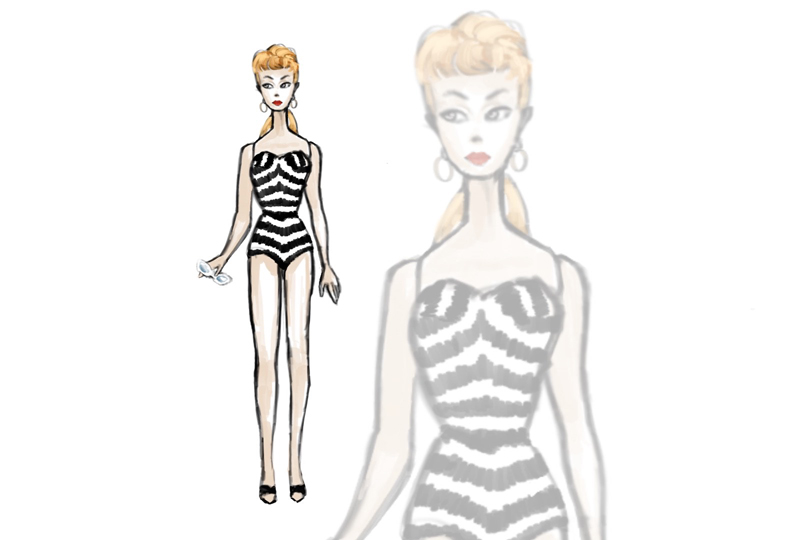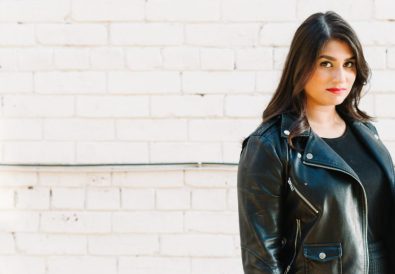Part of an ongoing series of 29Secrets stories, taking a deep dive into the history of legendary beauty products and iconic fashion moments…
By Christopher Turner
Illustration by Michael Hak
It’s the toy that became a symbol of empowerment, making history and changing pop culture forever. When Barbie made her debut in the spring of 1959 at the American International Toy Fair in New York City (wearing a black and white zebra-striped swimsuit and signature topknot ponytail), she was unlike any plaything in history. The launch wasn’t an immediate home run: it took some time, and innovative marketing, for manufacturer Mattel to turn her into a success. But success certainly came: during the first year of production, an astounding 350,000 dolls were sold. Hard to believe that no one initially wanted to bet on the adult-inspired doll.
Now, 64 years later, she’s still selling strong with no signs of slowing down. In fact, today a Barbie doll is sold every three seconds around the globe.
What’s her appeal? Antiques appraiser Lori Verderame, an expert on Barbie, told Newsweek in 2022 that what initially made the doll an unattractive prospect for buyers is exactly what made her appealing to consumers.
“Barbie was a different type of doll and such a doll was untested in the market,” Verderame said. “Barbie highlighted teen issues, an interest in contemporary clothing, young adult issues, how teens were considering adulthood and thinking about the future.”
The doll was created by forward-thinking businesswoman Ruth Handler, who used a novelty German doll as her inspiration. In her 1994 autobiography Dream Doll: The Ruth Handler Story, Handler said Barbie was designed to show that “a little girl could be anything she wanted to be.” Mission accomplished. Since her debut, Barbie’s full figure and impressive resumé has ensured that she was a different kind of doll for changing times.
Here’s a look back at the racy origins of the world’s most famous doll, and a brief look back at Barbie’s cultural revolution through the decades.
Mattel and an unlikely inspiration
The Mattel toy manufacturing company was founded as Mattel Creations in January 1945 by Harold “Matt” Matson, Elliot Handler and his wife, Ruth Handler. The company, which had its beginnings in a garage in Los Angeles, began by selling picture frames and, later, dollhouse furniture made of offcuts from those frames. A year after the company launched, Matson sold his share and stake to the Handlers due to poor health, and the Handlers worked together to turn the company into a success.
In 1947, Mattel had its first hit toy – a ukulele called “Uke-A-Doodle” – and the following year, it incorporated in Hawthorne, California. Of course, there were other successful toys launched in the early years, but nothing like what was on the horizon.
Ruth Handler saw a gap in the market for a toy resembling an adult woman after watching her preteen daughter, Barbara, play with paper dolls, dressing them up and role-playing a range of careers. At the time, the only dolls in the marketplace were modelled after babies, on the assumption that all little girls wanted to be mothers when they grew up. But times were changing, and throughout the 1950s discontent with the status quo was emerging.
Handler presented her idea of an adult-bodied doll to her husband and Mattel’s board of directors (who all happened to be men), but not one of them saw the adult doll’s potential.
“They were comfortable with toy guns and rockets, musical instruments and pop-up toys, but the doll Ruth described defied their imagination,” wrote business historian Robin Gerber in the 2009 book Barbie and Ruth: The Story of the World’s Most Famous Doll and the Woman Who Created Her.
During a trip to Switzerland in 1956 with her children Barbara and Kenneth, Handler came across a German toy doll called Bild Lilli. The Lilli doll was based on a popular cartoon character created by Reinhard Beuthien for the German tabloid newspaper Bild. Lilli was a blonde bombshell, a buxom, flirtatious working girl who knew what she wanted and was not above using men to get it. The racy comic was incredibly popular – so much so that in 1953, the newspaper decided to market a Lilli doll. After working with a few different toy manufacturers, Bild ultimately went into production with toy company O&M Hausser (which was started by Otto Hausser and his brother Max before Otto’s sons Rolf and Kurt took over). Rolf tasked O&M Hausser’s chief designer, Max Weissbrodt, with designing a prototype doll based on Beuthien’s sassy cartoons, and by 1955 the Lilli doll was being sold throughout Germany. Although it was initially sold to adults – mainly to men who gifted it to each other for their bachelor parties – the doll (which was available in two sizes: 12 inch and 7.5 inch) became popular with children, who enjoyed dressing her up in outfits that were available separately.
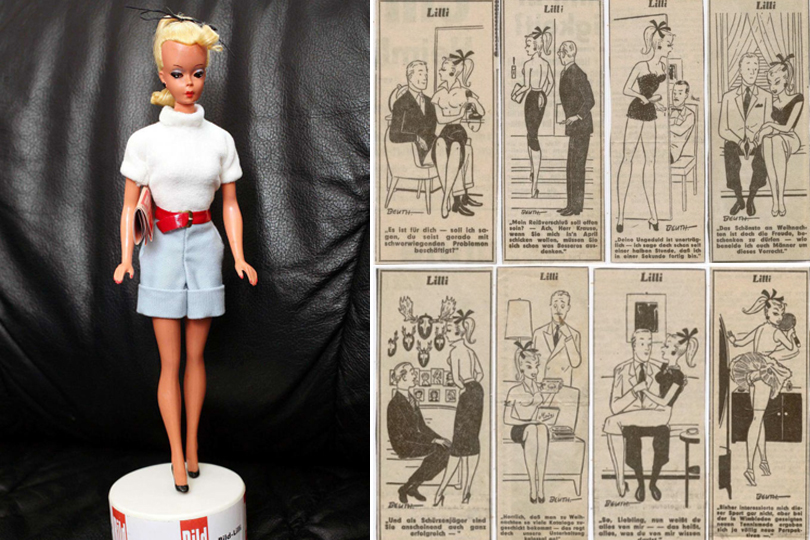
The adult-figured doll was exactly what Ruth Handler had in mind, so she purchased three Lilli dolls, gave one of them to her daughter, and took the other two back to the United States.
Back at the Mattel offices, Handler worked with local inventor-designer Jack Ryan on redesigning the German doll for the American market. The result? Something very similar to their inspiration: a leggy, 11-inch plastic figure with pouty red lips, a seductive side glance and a sassy topknot ponytail. She was given a new name, though: Barbie, after Handler’s daughter Barbara. (Barbie’s full name is Barbara Millicent Roberts.)
After the redesign was complete, the first Barbie dolls went into production and were manufactured in Japan, with their clothes hand-stitched by Japanese homeworkers.
Was Barbie an intentional Lilli knockoff? “Well, you might call it that,” Handler’s husband told biographer Jerry Oppenheimer in 2008’s Toy Monster: The Big, Bad World of Mattel. “Ruth wanted to adopt the same body as the Lilli doll with some modifications. Changes were made, improvements were made. Ruth wanted her own look.”
Barbie’s debut
The first Barbie doll was introduced as a “Teen-age Fashion Model” on March 9, 1959, at the American International Toy Fair in New York City. (Today, this date is used as Barbie’s official birthday.) The doll was available in both blonde and brunette, came with over-sized sunglasses, and wore a black and white zebra-striped swimsuit that was created by Mattel fashion designer Charlotte Johnson, mimicking the glamour of 1950s stars such as Elizabeth Taylor and Marilyn Monroe. Her backstory also mirrored that glamour: “Unlike most dolls at the time, Barbie was a grown-up – a teenage fashion model who could date, drive and wear fabulous clothes,” writes the National Museum of American History.
As for the cost? The first Barbie dolls sold for $3 each.
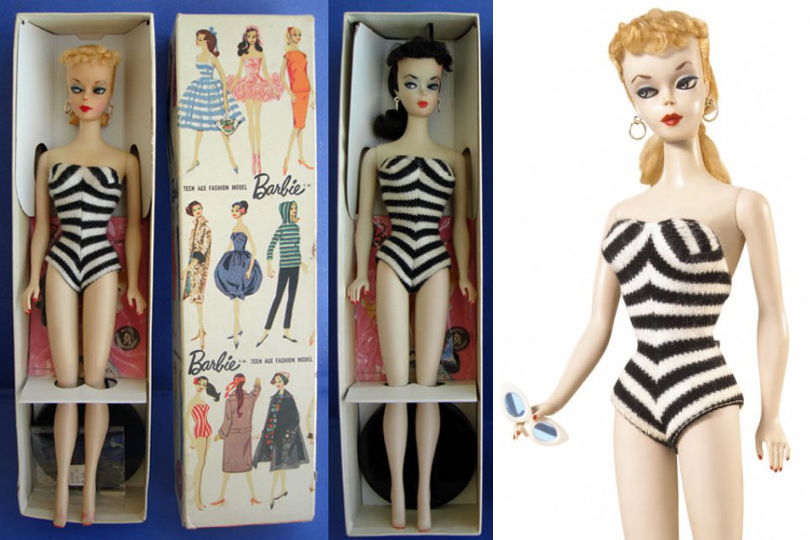
Handler’s vision wasn’t an immediate success. Barbie bombed when she debuted at the Toy Fair; buyers and advertising agencies were reluctant to give the adult-inspired doll a chance. As Mattel executives expected, sales from the major toy buyers were horrible. However, small orders from a few shops across the country came in, and those stores kept restocking the Barbie dolls over and over again.
“Toy buyers were sceptical because Barbie was unlike the baby and toddler dolls that were popular at the time,” toy maker Mattel writes in the online history of its most famous and still most profitable product. “They doubted she would be successful, but Barbie took the world by storm, letting girls imagine their futures like never before from that moment on.”
One of the reasons that Barbie caught on so quickly after an unsuccessful debut was how she was marketed. After the toy fair, Handler decided to market directly to consumers: in this case, children. Mattel had begun sponsoring the classic TV variety show Mickey Mouse Club in 1955, allowing them to broadcast their toy commercials to viewers. In the past, commercials had been targeted at parents, who chose toys for their kids. Barbie’s ad campaign bypassed mom and dad completely, and instead aimed to convince little girls that Barbie was the doll for them.
That’s not all. Handler convinced Mattel execs to sell their dolls at a loss. She predicted that Barbie would sell more at a low price point, giving Mattel an opportunity to capture the market. She intended for profits to come from Barbie’s clothing and accessories. Surprisingly, this approach was one of the first times this now-routine business model had been used.
It took some time, but the little girls of America – and then the world – soon proved the experts wrong. By the end of the first year of production, an astounding 350,000 dolls had been sold, and Barbie became the first mass-produced toy doll in the US with adult features.
It was just the beginning.
In 1961, two years after Barbie made her debut, Kenneth Sean Carson was introduced as Barbie’s on-again, off-again longtime boyfriend. Keeping with tradition, the Ken doll was named after the Handlers’ son, Kenneth. The fictional couple broke up in 2004 after 43 years together, but reunited in 2011. True love.
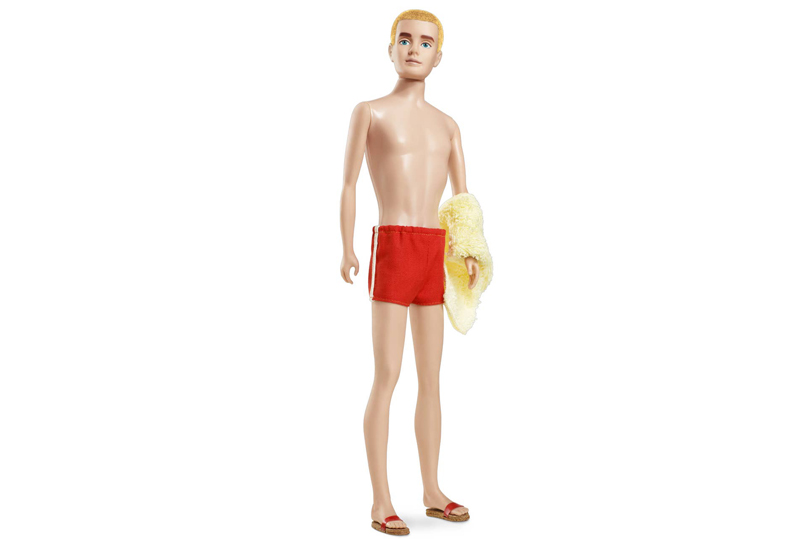
Barbie’s first controversies
Barbie’s popularity spread across North America and the world, and it wasn’t too long before the doll experienced her first of many controversies.
Rolf Hausser of O&M Hausser, inventors of the Bild Lilli doll, had no idea that their product had been knocked off and was rising to the top of the toy charts in the United States: “I knew nothing about what was happening in America. We didn’t even have a radio and there was nothing in the newspapers here about Barbie.” In fact, Hausser only found out about Barbie after stumbling upon the doll in a toy shop in Nuremberg, Germany, that had imported the dolls from Italy. “I was outraged when I saw this doll. This was my Lilli with a different name. What had these people done? Had they stolen my doll? I didn’t know what happened.”
In March 1961, as Barbie’s popularity was skyrocketing, Greiner & Hausser (the successors of O&M Hausser) attempted to sue Mattel for copyright infringement. They claimed that Mattel had “infringed on Greiner & Hausser’s patent for Bild Lilli’s hip joint,” and also claimed that Barbie was “a direct take-off and copy” of Bild Lilli. The company additionally claimed that Mattel “falsely and misleadingly represented itself as having originated the design.” The case was ultimately settled out of court in 1963. The following year, Mattel bought Greiner & Hausser’s copyright and patent rights for the Bild Lilli doll for $21,600 (equivalent to well over $200,000 today) and production of the German dolls ceased, allowing Mattel to downplay the connection between the two, with the more risqué doll becoming nothing more than a historical footnote. Or so they thought.
But that wasn’t the last time Lilli would rear her ponytailed head: decades later, in 1983, Greiner & Hausser collapsed. In 2001, the company’s court-appointed liquidator filed a lawsuit against Mattel, claiming that the company had been pressured into the settlement back in the ’60s, and that it was owed royalties on every Barbie doll that had been sold since 1964. That case was eventually dismissed by the courts.
Another ongoing controversy for the beloved doll has been her appearance. Barbie’s physical appearance has repeatedly been the subject of controversy since her early years. While Ruth Handler believed from the beginning that it was important for Barbie to have an adult appearance, early market research showed that some parents were pretty unhappy about that decision and about the plastic doll’s chest, which had distinct breasts.
Of course, it wasn’t just about Barbie’s breasts. The conversation about whether the doll promotes an unrealistic body image and beauty standards for children has haunted Mattel since the very beginning. To help counteract criticisms that Barbie was solely a sex symbol, Mattel gave her a best friend, Midge Hadley, introduced in 1963. A year later, they gave her a little sister: Skipper Roberts.
The newly introduced dolls with their differing proportions didn’t quite appease everyone. It’s not news that Barbie’s proportions are unrealistic, but just how unrealistic is still a shock. According to the “Slumber Party Barbie” pack, released in 1965, Barbie only weighs 110 lb – unsurprising, since the doll came with a diet book reading “Don’t eat.” One eating disorder group pointed out that given her height and weight, Barbie would have a BMI of 16.24 and would fit the criteria for anorexia.
Barbie’s appearance has been tweaked numerous times throughout the years to respond to criticism, most notably in 1971, when the doll’s eyes were adjusted to look forward rather than having the demure (and seemingly seductive) sideways glance of the original model. The change meant the doll ultimately made eye contact with the holder.
Barbie’s eyes would be the last adjustment that Handler would make to her creation as, three years later in 1974, she and her husband were removed from their posts at the company they had founded, after an investigation found them guilty of issuing false and misleading financial reports.
But, back to Barbie. Another controversy that surrounded Barbie throughout the years was the lack of inclusivity. Christie, an African American doll first introduced in 1968, was advertised as Barbie’s friend in an attempt to create a racially diverse Barbie world. Christie had the same body as Barbie so that their clothes were interchangeable, but Christie had black hair and her face was a new design intended to highlight the facial features of a Black woman. Many consider Christie to be the first “Black Barbie,” but technically she wasn’t. The first official African American Barbie wasn’t created until 1980, when Mattel started offering three versions of Barbie: a white Barbie, a Black Barbie and a Latina Barbie. That same year also saw the first of more than 40 different international Barbies released to date.
Mattel is still plagued with problems surrounding image and inclusivity. But they are continuously working to improve the line and have made great strides to make it more inclusive. In 2017, Mattel introduced the first Barbie to wear a hijab. In 2019, the company upped its line to include dolls with braided hair texture and more body shapes (smaller bust, less defined waist and more defined arms), as well as a Barbie with a prosthetic leg and another that comes with a wheelchair, which were a hit with disability rights activists.
It’s symbolic that “a big icon of society like Barbie now demonstrates or shows that there are different types of people…[who] can be attractive and something kids want to play with,” said Curt Decker, executive director of the National Disability Rights Network in 2019.
More recently, the company has released a version of the iconic doll with a hearing aid, and a Ken doll with vitiligo. Each doll is part of Mattel’s strategy to offer kids more diverse representations of beauty: a step in the right direction for sure.
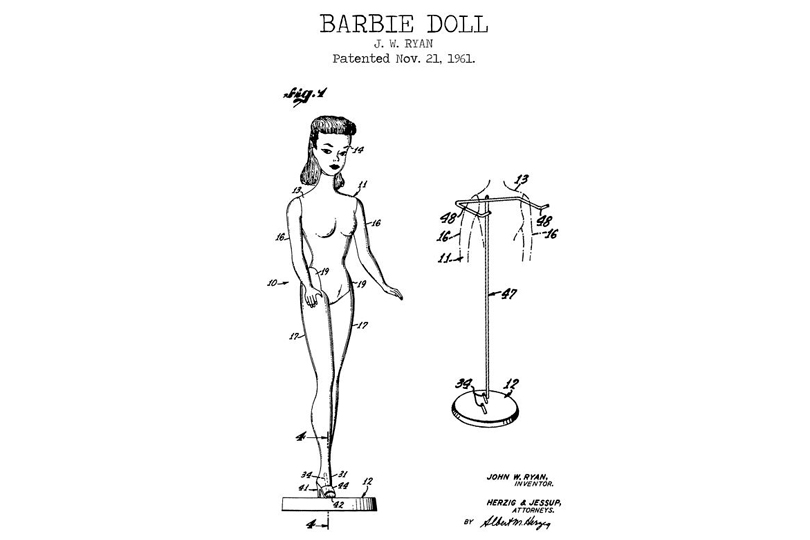
Keeping up with Barbie
One of the reasons Barbie is still so influential in 2023 is thanks to Mattel’s ability to (mostly) stay up to date with evolving social norms. Since her debut in 1959, Barbie has adapted to the cultural and social changes of the decades from the 1960s to today. One of the ways she’s done that is through her jobs. Believe it or not, Barbie has had more than 150 careers, including doctor, scientist, lawyer, astronaut, mermaid, and even President of the United States. (Fun fact: Mattel has released a Barbie for President doll for almost every US election since 1992, with 2016’s version having a female vice president as well.)
Of course, that was always Handler’s intention for her creation.
“My whole philosophy of Barbie was that through the doll, the little girl could be anything she wanted to be,” Handler wrote in her 1994 biography. “Barbie always represented the fact that a woman has choices.”
Today
Sales may have dropped in recent years, but Mattel has moved more than one billion Barbie dolls in the six-plus decades since she made her debut, with consumers purchasing about 58 million dolls per year. In fact, Mattel claims that a Barbie doll is sold every three seconds around the world.
It’s not just dolls. Barbie became big business when Mattel branched into media with movies, TV and video games in the late 1980s. Next? An upcoming live-action romantic comedy film based on the eponymous fashion doll. Warner Bros’ Barbie, directed by Greta Gerwig and starring Margot Robbie as Barbie and Ryan Gosling as Ken, is scheduled to hit theatres across North America on July 21, 2023. It is the first live-action Barbie film after countless computer-animated direct-to-video, streaming and television films. Anticipation for the movie is high, but details have stayed mostly under wraps. (An early synopsis reads: “After being expelled from Barbieland for being a less than perfect-looking doll, Barbie sets off for the human world to find true happiness.”)
“A less than perfect-looking doll” is a dramatic turn from the days when some considered Barbie – with her blonde hair, blue eyes and unrealistically proportioned body – to be the perfect woman.
“While often criticized for her unrealistic physical proportions and for promoting gender stereotypes, Barbie has also evolved with the times to reflect social and cultural changes in American culture,” writes the National Museum of American History.
It’s true. Barbie has had an undeniable impact on culture, and has cemented her place in history as a symbol of empowerment, changing pop culture forever. Wonder what she’ll be next?
![]()
Want more? You can read other stories from our The Story Of series right here.

